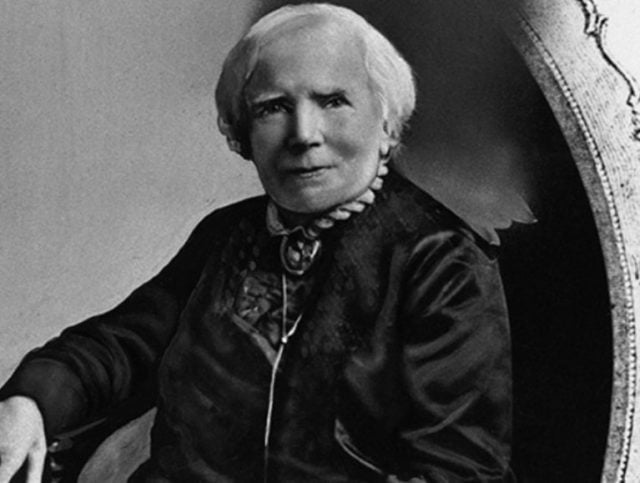In January 1849, Elizabeth Blackwell made history as the first officially accredited physician in the United States, setting a new path for women in medicine around the world. As the first of her kind, Blackwell faced several challenges in the early years of her medical career. However, she survived them all and made a name for herself as a role model for aspiring female doctors both in the United States and in her home country, the United Kingdom. Blackwell’s birthday – February 3 – will be celebrated as National Women’s Day in recognition of her efforts to promote the education of women in medicine.
Elizabeth Blackwell Bio
Elizabeth Blackwell was born in Bristol, England, on February 3, 1821, the daughter of Hannah and Samuel Blackwell. In her upbringing, her parents represented a liberal outlook on education, religion, and social ideologies. The male and female children of the family were given equal educational opportunities. She had private tutors and other conditions that would allow her to develop her abilities without limits. It turned out, however, that she was easily socially isolated from her peers. In 1832, the Blackwells emigrated to the United States, settled in New York City, and six years later moved again to Cincinnati, Ohio.
Siblings
Elizabeth Blackwell grew up in a large household. She had 2 older siblings Anna and Marian and 6 younger ones, Samuel, Henry, Emily, Sarah Ellen, John, and George. Her family ran into financial difficulties in early adulthood, and in an effort to supplement the family income, Blackwell and her older sisters Anna and Marian founded a school called The Cincinnati English and French Academy for Young Ladies.
ALSO READ: Who is Dante Cunningham? His Wife, Girlfriend, Height, Weight
Blackwell converted to Episcopalianism in December 1838 but later switched to Transcendentalism after William Henry Channing, a charismatic Unitarian minister, arrived in 1839. Her conversion to the Unitarian Church triggered a furious backlash from the conservative community in Cincinnati, and as a result, the student population of the Academy shrank, culminating in the closure of the school in 1842.
Education
Elizabeth Blackwell’s conversion to the Unitarian Church also awakened her desire for intellectual self-improvement. While working as a teacher to pay her bills, she began an aggressive search for knowledge through the study of art, attending lectures, and also participating in the worship services of all the sects.
While working as a teacher in Asheville, North Carolina, and later in Charleston, South Carolina, she began to save for the cost of medical studies. Initially, she considered the possibility of studying medicine by correspondence, but this was not answered positively. Blackwell finally moved to Philadelphia in 1847 with the desire to be accepted into one of the medical schools there. She met with fierce resistance at every turn, however, and advised her to either disguise herself as a man in order to study medicine or to move to Paris for her studies, which she refused to do.
In October 1847 she was finally accepted into the Geneva Medical School (now Hobart College) after her application was unanimously accepted by the school’s 150 all-male student body. Blackwell’s challenges remained, however, even after her admission to medical school. Her attempts to gain clinical experience during her summer vacation in Philadelphia were rejected as she was rejected by several institutions in the area. When she was finally admitted to Blockley Almshouse, she received early resistance from a number of young doctors who refused to help her care for her patients. Despite the shortages, she managed to complete her studies and graduate from medical school.
On January 23, 1849, Elizabeth Blackwell was awarded her medical degree, and the local press reported well on her graduation. In April 1849 she moved to Europe where she completed further studies in obstetrics and pediatrics. She first enrolled at La Maternité, a maternity clinic in Paris, France, on the premise that she would be considered a trained midwife rather than a physician. Her employment at this institution ended in November 1849 after she accidentally contracted an eye infection that eventually cost her the use of one eye.
After a long period of treatment and recovery, Blackwell enrolled at St. Bartholomew’s Hospital in London in 1850, where she met with some resistance. The following year she finally returned to New York City in the hope of opening her own practice. However, she had few patients in the first year of her private practice, which was due to the mistaken assumption that female doctors were stereotypically abortionists. Blackwell also edited several publications and lectured while her medical career flourished.
Accomplishments
In 1858, Elizabeth Blackwell, together with her sister Emily Blackwell, who had also studied medicine, and Marie Zakrzewska, a young doctor from Poland, set up a pharmacy – the New York Hospital – for women and children in need. The facility was the first of its kind, as its board of directors and attending physicians were women.
On January 1, 1859, Blackwell became the first female doctor to be included in the British Medical Register, based on a provision of the Medical Act of 1858 that allowed doctors with foreign degrees to practice in Great Britain before 1858.
The London School of Medicine for Women was founded in 1874 by Elizabeth Blackwell and Sophia Jex-Blake. Blackwell later lost much of her influence in the institution to Jex-Blake and was elected as a lecturer in midwifery, a position she gave up in 1877.
In addition to her groundbreaking career as a doctor, Blackwell was also an outstanding author and activist for social reform. She was interested in a number of reform movements, all of which were directed toward the goal of “evangelical moral perfection. A staunch conservative, she was strongly opposed to licentiousness, prostitution, and the use of contraception.
Death
Elizabeth Blackwell remained active even at the age of eighty, although her activities were severely limited by age. She fell off a staircase during a vacation in Kilmun, Scotland, in 1907, leaving her almost mentally and physically incapable. She died 3 years later, on May 31, 1910, at her home in Hastings, Sussex, after suffering a partial stroke. Her ashes were deposited in the cemetery of St. Munn’s Parish Church in Kilmun.
ALSO READ: Bill Skarsgard Biography, Siblings, Girlfriend and Family Life
Other Interesting Facts About Elizabeth Blackwell
The Elizabeth Blackwell Medal is awarded annually by the American Medical Women’s Association to a physician who has made great strides in promoting the cause of women in the medical field. The award was established in 1949, a century after Blackwell’s medical studies.
Blackwell’s younger sister, Emily Blackwell, also followed in her sister’s footsteps in medicine and was the third woman to complete a medical degree in the United States. Like her older sister, Emily Blackwell was rejected in several medical schools before she was finally accepted into the Medical College of Cleveland, Ohio (now the Case Western Reserve School of Medicine). She graduated in 1854, and among other collaborations, the Blackwell sisters founded the Women’s Medical College in New York City in 1868.
In 1856 Elizabeth Blackwell adopted the Irish orphan Katherine “Kitty” Barry (born 1848) from the New York City refuge. Barry’s education was well provided for, although she did not have the freedom to pursue her own interests. She accompanied Blackwell on her many journeys and stayed with her until her death. After Blackwell’s death in 1910, Barry moved to Kilmun in Argyllshire, Scotland. Later she moved in with the surviving Blackwells and took the surname “Blackwell”.





